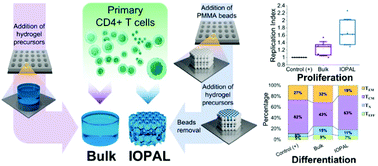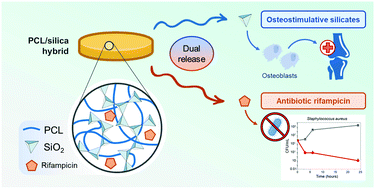Themed collection 31st Annual Conference of the European Society of Biomaterials

Introduction to the 31st Annual Conference of the European Society for Biomaterials (ESB 2021)
Ana Paula Pêgo, M. Cristina L. Martins and Pedro L. Granja introduce the themed issue on the 31st Annual Conference of the European Society for Biomaterials (ESB 2021).

Biomater. Sci., 2022,10, 5031-5031
https://doi.org/10.1039/D2BM90060B
Tissue engineered scaffolds for corneal endothelial regeneration: a material's perspective
An overview of scaffolds for corneal endothelial tissue engineering, their properties and materials starting from the Descemet's membrane and evaluating the scaffolds from a materials scientist perspective.

Biomater. Sci., 2022,10, 2440-2461
https://doi.org/10.1039/D1BM02023D
Superparamagnetic iron oxide nanoparticles for magnetic hyperthermia: recent advancements, molecular effects, and future directions in the omics era
Coating and targeting strategies improve superparamagnetic iron oxide nanoparticles-induced hyperthermia, while omics can unveil molecular effects.

Biomater. Sci., 2022,10, 2103-2121
https://doi.org/10.1039/D1BM01963E
Porous yet dense matrices: using ice to shape collagen 3D cell culture systems with increased physiological relevance
Porous yet dense collagen matrices obtained by ice templating allow for long-term 3D cell culture with enhanced physiological relevance.

Biomater. Sci., 2022,10, 6939-6950
https://doi.org/10.1039/D2BM00313A
High-performance bilayer composites for the replacement of osteochondral defects
Two novel bilayer constructs for the repair of osteochondral defects were developed from nanofibers and ceramic particles embedded into PVA matrices, exhibiting multiple promising properties similar to those of corresponding natural tissues.

Biomater. Sci., 2022,10, 5856-5875
https://doi.org/10.1039/D2BM00716A
Piezoelectric nanocomposite bioink and ultrasound stimulation modulate early skeletal myogenesis
A cell-laden alginate/Pluronic-based bioink doped with BaTiO3 piezoelectric nanoparticles (BTNPs) was investigated. BTNPs promoted myogenic differentiation and the synergy with ultrasound boosted the expression of MYOD1, MYOG, and MYH2 genes.

Biomater. Sci., 2022,10, 5265-5283
https://doi.org/10.1039/D1BM01853A
Antimicrobial activity of piezoelectric polymer: piezoelectricity as the reason for damaging bacterial membrane
Piezoelectric poly-L-lactide nanotubes mechanically deformed with ultrasound selectively destroy bacterial membranes, exhibiting a contact-based antimicrobial effect.

Biomater. Sci., 2022,10, 4933-4948
https://doi.org/10.1039/D2BM00644H
Inter-donor variability of extracellular matrix production in long-term cultures of human fibroblasts
Several tissue engineering approaches are based on the ability of mesenchymal cells to endogenously synthesize an extracellular matrix (ECM) in vitro, which can be seen as a form of biomaterial.

Biomater. Sci., 2022,10, 3935-3950
https://doi.org/10.1039/D1BM01933C
Thermosensitive hydrogels to deliver reactive species generated by cold atmospheric plasma: a case study with methylcellulose
Hydrogels have been recently proposed as suitable materials to generate reactive oxygen and nitrogen species (RONS) upon gas-plasma treatment, and postulated as promising alternatives to conventional cancer therapies.

Biomater. Sci., 2022,10, 3845-3855
https://doi.org/10.1039/D2BM00308B
Enhanced human T cell expansion with inverse opal hydrogels
Lymph node-inspired 3D hydrogels with precisely defined porosity were produced, which improve the state-of-the-art T cell proliferation, a procedure that is especially important for novel cellular immunotherapies.

Biomater. Sci., 2022,10, 3730-3738
https://doi.org/10.1039/D2BM00486K
Manufacturing, characterization, and degradation of a poly(lactic acid) warp-knitted spacer fabric scaffold as a candidate for tissue engineering applications
Three-dimensional bioabsorbable textiles represent a novel technology for the manufacturing of tissue engineering scaffolds.

Biomater. Sci., 2022,10, 3793-3807
https://doi.org/10.1039/D1BM02027G
Tailoring the dissolution rate and in vitro cell response of silicon nitride coatings through combinatorial sputtering with chromium and niobium
The addition of alloying elements, in particular chromium, reduced the dissolution rate of silicon nitride coatings without affecting other functional properties such as hardness. Optimum chromium contents gave an enhanced in vitro cell viability.

Biomater. Sci., 2022,10, 3757-3769
https://doi.org/10.1039/D1BM01978C
In vitro study of polydopamine nanoparticles as protective antioxidant agents in fibroblasts derived from ARSACS patients
PDNPs elicit an antioxidant effect on healthy and ARSACS-derived fibroblasts, thus reducing ROS levels, ROS-induced apoptosis/necrosis, and ROS-induced mitochondrial impairments, and enhancing protein expression.

Biomater. Sci., 2022,10, 3770-3792
https://doi.org/10.1039/D2BM00729K
One sample fits all: a microfluidic-assisted methodology for label-free isolation of CTCs with downstream methylation analysis of cfDNA in lung cancer
Combinatorial assessment of lung cancer biomarkers via microfluidics-assisted liquid biopsy.

Biomater. Sci., 2022,10, 3296-3308
https://doi.org/10.1039/D2BM00044J
Development of electrospun, biomimetic tympanic membrane implants with tunable mechanical and oscillatory properties for myringoplasty
The mechanical and oscillatory behavior of the biomimetic electrospun SF-PCL TM implants can be tuned by adjusting the solution concentration, the SF-PCL mixing ratio and the electrospinning parameters to achieve comparable properties to human TMs.

Biomater. Sci., 2022,10, 2287-2301
https://doi.org/10.1039/D1BM01815A
Investigation and comparison of resin materials in transparent DLP-printing for application in cell culture and organs-on-a-chip
Transparent, cytocompatible and high resolution 3D-DLP-printing offers new opportunities in cell culture and organs-on-a-chip.

Biomater. Sci., 2022,10, 1981-1994
https://doi.org/10.1039/D1BM01794B
Tailored therapeutic release from polycaprolactone-silica hybrids for the treatment of osteomyelitis: antibiotic rifampicin and osteogenic silicates
Polycaprolactone/silica hybrids offer a dual therapeutic effect: the promotion of bone regeneration thanks to silicate ions and strong antibacterial properties against the risk of osteomyelitis.

Biomater. Sci., 2022,10, 1936-1951
https://doi.org/10.1039/D1BM02015C
Dual keratinocyte-attachment and anti-inflammatory coatings for soft tissue sealing around transmucosal oral implants
A dual keratinocyte attachment cell adhesive peptides (CAPs) and anti-inflammatory conjugated linoleic acid (CLA) coating as a strategy for promoting soft tissue sealing around transmucosal implants.

Biomater. Sci., 2022,10, 665-677
https://doi.org/10.1039/D1BM01649K
Liposomes loaded with polyphenol-rich grape pomace extracts protect from neurodegeneration in a rotenone-based in vitro model of Parkinson's disease
Liposomes were loaded with a polyphenol-rich extract from grape pomace. Liposomes successfully crossed the BBB and efficiently protected neural cells from neurodegeneration in relevant in vitro models.

Biomater. Sci., 2021,9, 8171-8188
https://doi.org/10.1039/D1BM01202A
Cell morphology as a design parameter in the bioengineering of cell–biomaterial surface interactions
Identifying an optimal range of cell morphology characteristics to monitor cell–surface interactions, helping to screen biomaterial applications such as cell sheets, intelligent cell culture surfaces, or functional coatings.

Biomater. Sci., 2021,9, 8032-8050
https://doi.org/10.1039/D1BM01149A
About this collection
This collection showcases some of the research that was presented at the 31st Annual Meeting of the European Society for Biomaterials in September 2021. As the official journal of the European Society of Biomaterials (ESB), Biomaterials Science works in partnership with the European Society of Biomaterials to highlight some of the most interesting research from the community on the conference topic of ‘Future with Biomaterials'.